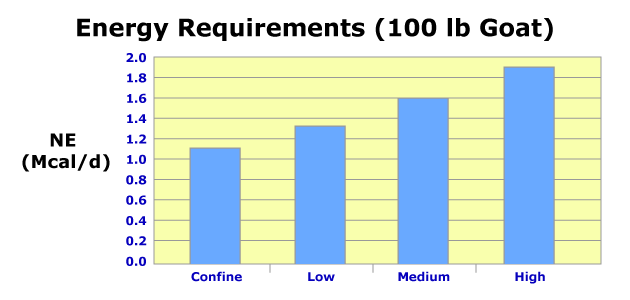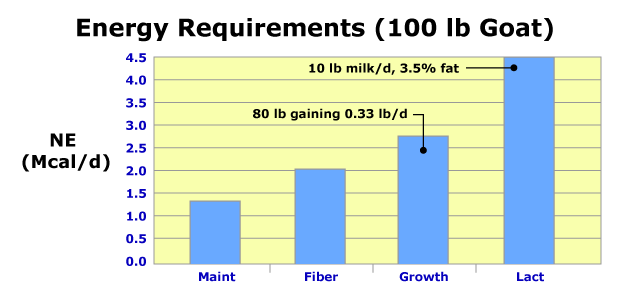Previous Page | Right click this page to print.
Nutrients
Now if you look at or compare goats to other species and intake on a percent of body weight, how much will beef cows consume on a percent of body weight? Two and a half, three percent if it’s high quality, can go down to two percent or below if it’s very poor quality, right? What about dairy cows, how much you think they consume as a percent of body weight? It is going to be at least more than the highest consuming beef cows, right? So 3% at the minimum, they can go up to 4 1/2 – 5%. Goats will consume, as a percent of body weight, more dry matter per day than most other species. The reason they do this is the reticulorumen is smaller and the retention time of feed particles is much shorter in goats. If you feed cows an alfalfa hay diet and you feed goats an alfalfa hay diet, the retention time is less in goats, so the passage rate is quicker. If you move something out of the rumen quicker, what is the digestibility of it compared to if you leave it in there longer? Less, right. The more time feedstuffs stay in the rumen, the more that they will be digested. The digestibility of diets for goats compared to those of cows will always be lower, if you feed them the same thing, because passage rating goats is much quicker. The way they compensate for this is that they consume more dry matter a day and so they still meet their energy and protein requirements.
Here’s the retention time of a similar diet for cattle, sheep and
goats.
RT (h) |
TR (%/h) |
Digestibility (%) |
|
|---|---|---|---|
Cattle |
36 |
5.2 |
51 |
Sheep |
34 |
5.2 |
50 |
Goats |
28 |
7.1 |
45 |
Huston et al. (1986)
So it was the greatest for cattle, intermediate for sheep and had the slowest retention time in goats. This is turnover percent, so turnover of feed in the rumen, this is percent per hour. This is pretty common for average quality diets for sheep and cattle, about 5% per hour. How does that compare to goats? Just look at the numbers, 5.2 versus 7.1. The turnover rate of feed particles in the rumen is greater for goats than cattle or sheep. What about the digestibility? It has to be less, right, because feed particles move through quicker. The faster turnover, feed particles move through the rumen quicker, results in increased consumption. Sp they compensate for this decreased digestibility by increased consumption. The total nutrient that they digest will be actually higher than other ruminants.
Goats need energy for the same functions as any other animal, maintenance,
growth, reproduction and lactation. If they’re mohair goats, Angora
goats they would also need energy for fiber production and activity.

Activity is really what sets goats apart from maybe some other, or especially the other ruminants, as they are much more active, they usually travel further each day. As activity increases you would expect energy requirements to increase. If goats are in intensive management, so rotational grazing, or tropical range where they have lots of vegetation to choose from, activity does not increase very much. You would increase maintenance requirements by about 25%. But when they get on very arid range or arid climates, mountainous pastures, activity can increase maintenance requirements by about 75%. These would be the energy requirements of goats in confinement; low, medium and high activity and this is a 100 pound goat. In confinement, goats need about 1 to 1.1 megacals of energy per day for maintenance. As you move to very high activity, this increases by about 75%, so now they need about 1.8 or 1.9 megacals of energy for maintenance.
This chart compares does at maintenance, does producing fiber, kids that
are still growing and does that are lactating.

This is the same for beef cows, dairy cows, sows, mares. Who usually
requires the most nutrients? This is energy on the table, it could also
be protein, calcium. Lactating animals always require more nutrients than
other animals. We have this goat at maintenance again at about 1.2 megacals.
If we have a doe that is producing about 10 pounds of milk a day at about
3.5% fat, she would need about 3 times, 4 times as much energy as a doe
at maintenance.
Previous Page | Right click this page to print.